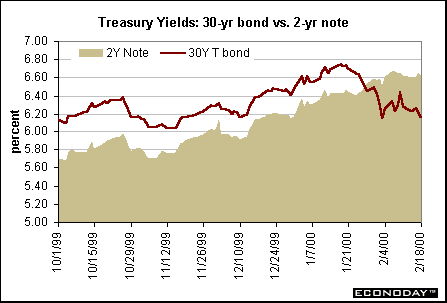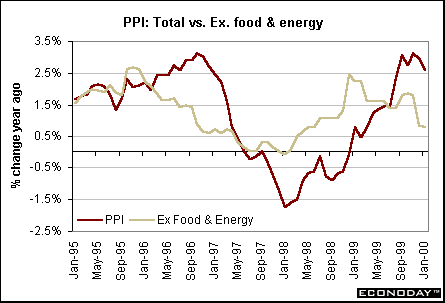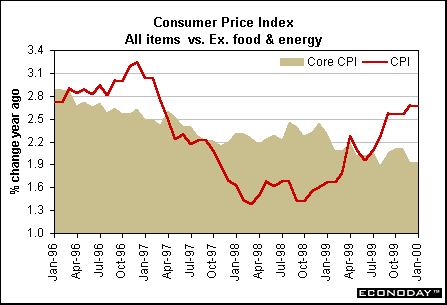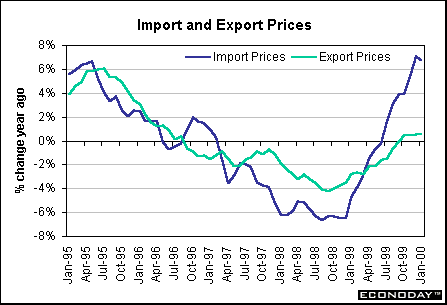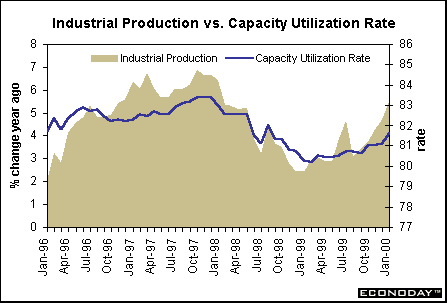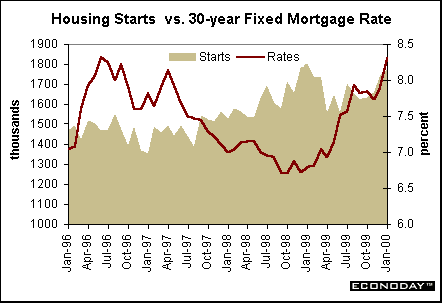| |||||||||||||||||||||||||||||||||||
| Previous Articles |
|
It's
all about Greenspan Greenspan's comments were generally not all that different from earlier speeches. He's worried about imbalances in the economy that are coming from excessive demand. He is concerned that consumer spending is outpacing income growth by a strong margin and that household wealth is growing about twice as fast as income -- and helping to support the strong consumer demand. Greenspan believes that productivity could continue to grow at a healthy pace in coming months, but even that may not be enough to hold wage pressures in check. He admits that inflation appears benign, but rising energy prices may eventually cause greater disruptions. Basically, he feels that asset prices (equity prices) need to grow at a slower pace so that the "wealth effect" which causes consumers to spend more than they earn will diminish. It almost appears as though he wishes to target the equity market now.
The NASDAQ composite index and the Russell 2000 have gained new territory this week even though they tumbled on Friday with the rest of the market. The NASDAQ composite is growing rapidly because investors believe potential returns in tech stocks are clearly greater than current market interest rates -- even with further rate hikes by the Fed. The Russell 2000 -- the primary index of small-capitalization stocks -- does have a strong element of technology which is contributing to its rise. However, the gains in this index are somewhat more broad-based helping small-cap stocks in several industries. Treasury
Market stabilizes
Markets
at a Glance Weekly
(BP = basis points; stock price indices are rounded) Favorable
inflation news helps dampen Greenspan effect
As the probability of inflation increases over the maturity of an economic expansion when resources are tight, market participants look to every possible leading inflation index. Among producer price indices, one would expect that the crude materials index and the intermediate goods index to give a heads up on inflation in the pipeline. We have found that these indices don't always lead the finished goods index, but they could very well signal a squeeze in profit margins. In January, the crude materials index jumped 2.7 percent -- with the nonfood, nonenergy component gaining 3.2 percent. Nonfood, nonenergy raw materials prices are now 16.9 percent higher than a year ago. The jump in raw materials prices hadn't yet seeped into intermediate goods prices which rose 0.4 percent in January. Excluding food and energy, they were up 0.3 percent for the month, but are only 2.4 percent higher than a year ago. Incidentally, the PPI for finished goods (excluding food and energy prices) is only up 0.8 percent from a year ago. Let's call that profit-squeeze. The consumer price index rose 0.2 percent in January, the same as the past several months. Food prices were unchanged, but energy prices increased 1 percent. Excluding food and energy prices, the CPI rose 0.2 percent in January, after a smaller 0.1 percent hike in December. The price behavior among the various components was quite similar to previous months, although apparel prices fell sharply. In contrast to the PPI, tobacco prices rose in the CPI reflecting higher taxes on cigarettes.
Notice the upward trend in the CPI in the chart above. Total consumer prices are up 2.7 percent from year ago levels. Excluding food and energy, though, the core CPI is actually recording smaller year-over-year increases and was up 1.9 percent in January 2000. Unfortunately, we can't eliminate food or energy from our budget, so the total CPI is the appropriate measure to look at over a longer time horizon than just one month.
The bottom-line on inflation? Inflation news is favorable for the most part. Producer prices are subdued and the bulk of the rise in the consumer price index stems from energy. Import prices showed that energy prices continue to rise, but at a slightly slower rate from a year ago. Global competition is keeping export prices in check. Basically, the Fed is worrying about inflation because of its potential to accelerate. Acceleration in prices at earlier stages of processing does indicate that Fed officials need to be on high alert for price pressures. As Greenspan indicated at the Humphrey-Hawkins testimony, the Fed prefers a gradual approach to policy changes because it helps keep financial markets more stable. These kind of inflation figures support gradual increases of 25 basis points in the federal funds rate target going forward, not a swift spurt in the funds rate target as some market players had feared earlier in the year. Industrial
hustle and bustle
As industrial production has picked up, so has the capacity utilization rate. In the past, a utilization rate approaching the neighborhood of 83 to 85 percent signaled supply bottlenecks and inflationary pressures. In a global environment, that may be less important. In any case, current levels are not in the danger zone yet. The bottom-line on production? In the previous couple of years, domestic production was on the anemic side even as the demand for services surged. This helped to keep resource limitations in check because U.S. consumers and producers satisfied demand by purchasing foreign goods. As domestic production picks up steam, it creates greater concern from Fed officials who are trying to cool down economic activity. Current production growth certainly supports the Fed's intention to tighten credit conditions further in coming months. Housing
activity: as strong as ever
The bottom-line on housing? Typically, economists and policy-makers look at single family housing starts to gauge housing demand, which is sensitive to interest rates. While single family housing units declined modestly in January, the average level for the past three months is higher than three months ago. Ergo, housing remains way too healthy given the Fed's inclination to cool down this hot economy. The chart above shows that mortgage rates have risen sharply in the past few months, but higher rates are obviously necessary to dampen construction activity. THE
BOTTOM LINE Activity in the economy is hopping. Industrial production surged in January and housing starts continue to surpass expectations. Alan Greenspan testified before the House Banking Committee this week for his semi-annual Humphrey-Hawkins remarks. His views haven't changed from earlier this year, but he seemed a bit more adamant about the potential for inflation and the fact that the economy is showing no signs of slowing down. Market players would say that he sounded "hawkish". Looking
Ahead: Week of February 21 to February 25 Wednesday
Thursday
The consensus shows that durable goods orders could decrease 2.0 percent in January after a 5.5 percent boost in December. This would be a modest drop after several strong months at the end of 1999. Also, it would reflect a drop in the volatile aircraft sector. Friday
The market consensus shows that existing home sales should decline 1.2 percent in January to a 5.0 million unit rate. This partly reflects slower growth coming from higher mortgage rates. |
|||||||||||||||||||||||||||||||||||||||||||||||||||||||||||||||||||||||||||||||||||||||||||||||||||




